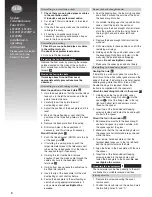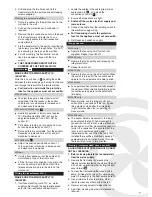
If ceiling mounting the fan
Use the appropriate ancillaries for termination.
These items are available from Xpelair.
1. WT10 - Termination ducting kit.
2. CFWG100 - Soffit board termination grille
(white or grey).
3. FD100/3 and FD100/6 - flexible ducting.
Where to locate it
Fan
•
Locate it as high as possible.
•
At least 110mm from the edges of the
mounting surface to the centre of the hole.
•
As far away as possible from and opposite to
the main source of air replacement to ensure
airflow across the room (e.g. opposite the
internal doorway).
•
Near the source of steam or odours.
•
Not where ambient temperatures are likely
to exceed 50˚C.
•
If installed in a kitchen fans must not be
mounted immediately above a cooker hob,
or eye level grill.
•
If installing in a room containing a fuel
burning device which has a non-balanced
flue, it is the installers responsibility to
ensure that there is enough replacement air
to prevent fumes being drawn down the
flue when the fan is operating up to
maximum extract. Refer to Building
Regulations for specific requirements.
•
Exhaust air must not be discharged into a
flue used for exhausting of fumes from
appliances supplied with energy other than
electric. Requirements of all authorities
concerned must be observed for exhaust
air discharge and intake flow rates.
•
When intended for use in possible
chemical corrosive atmospheres, consult
our Technical Service Department.
(For overseas markets contact your local
Xpelair distributor).
•
LV100PIR Only - Siting must ensure
detection of movement. Care should be
taken to avoid any obstructions that may
affect detection beams
A
.
Transformer
•
In a loft or any convenient position on a wall
(not suitable for ceiling mounting).
The transformer must not be covered by
loft insulation
.
•
Must be positioned the correct way up to fulfil
ingress protection requirements.
•
Not within 0.6m of a bath or shower cubicle, up
to a height of 2.25m.
•
Not where ambient temperatures are likely
to exceed 50˚C.
Installing the isolating switch and cables
1. Check that the electrical rating shown inside
the back plate matches your mains supply.
5
2. Check there are no buried pipes or cables
e.g. electricity, gas, water behind the
switch location (in the wall or above the
ceiling).
If in doubt, seek professional advice.
3. Isolate the mains supply.
4. Lay in the cable from the supply to the double
pole isolating switch.
5. Lay in the cable from the isolating switch to the
transformer location.
6. Lay in the cable from the transformer to the fan
location.
7. Install the isolating switch.
8. Make all connections within the isolating
switch.
Note: On/off switch must be so situated that
it cannot be touched by persons making use
of the bath or shower.
WARNING: DO NOT MAKE ANY
CONNECTIONS TO THE ELECTRICAL
SUPPLY AT THIS STAGE.
Preparing the hole for the fan
If working above Ground Floor level,
appropriate safety precautions must be
observed.
WARNING: EYE PROTECTION MUST BE
WORN DURING ALL DRILLING AND
CHISELLING OPERATIONS.
If installing in a wall
1. Check there are no buried pipes or cables
in the wall or obstructions on the outside
e.g. Electricity, Gas, Water.
If in doubt, seek professional advice.
2. Mark on the wall the centre of the duct hole.
3. Use this centre to mark a circle to suit the wall
duct (115mm diameter)
If core drill equipment is available
4a. Use as directed by Core Drill manufacturer.
If core drill equipment is not available
4b. Drill a centre hole right through the wall.
5. Cut the hole. Do not cut right through the wall,
cut from both sides. (The recommended
method is to drill a series of holes, close
together, around the edge of the cutting line
and remove the brick between the holes with a
chisel).
6. Go outside and cut a hole in the outer wall,
repeating the process described above.
7. Cut ducting to the correct length if required.
The wall tube supplied is telescopic and can
extend to 300mm maximum.
8. Fit the ducting. Ensure that the duct slopes
down away from the fan to allow drainage of
any incoming rain water to the outside.
9. Make good the hole. Allows the Mortar to set
before continuing the fan installation.
If installing in a window or panel
Cut a hole, 125mm in diameter. The centre of the
hole should be at least 110mm away from the
edge of the panel or pane of glass. It is
recommended that you obtain a ready cut pane
for window installation.




























